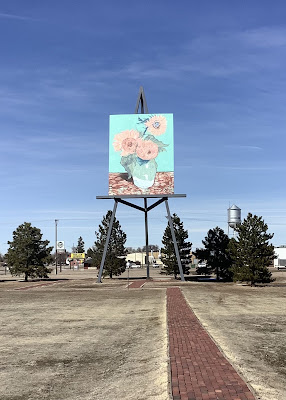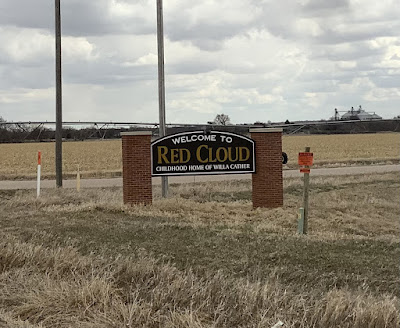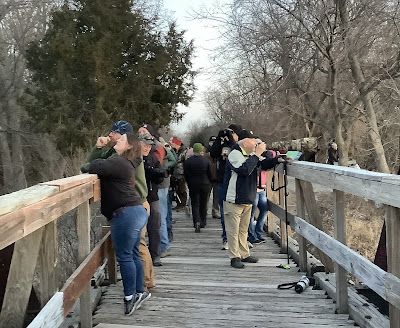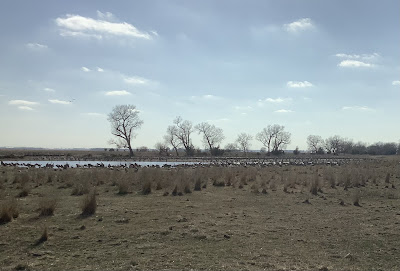

I had stopped to rest and eat in the negligible community of Edson, population 17, just down the street from its post office. I was leaning against the wall of closed mechanic’s shop in the sun when a small, beat-up, black pickup truck pulled into the parking lot. A scrawny, slightly unkempt older guy hopped out and blurted, “Do you need a place to stay? I live down the street. You can pitch your tent in my yard.”
Realizing he might have been too forward, he added, “I went to Kansas State and work at a truck mechanics in Goodland.” He opened his jacket and showed his overalls with “S & M Repair” on it.
He didn’t need to assure me that his forwardness was scaring me off and that I might take him as a homicidal maniac, though he might be. I was immediately captivated by his enthusiastic friendliness, recognizing a character I’d be happy to get to know.
It was just two in the afternoon, so I wasn’t ready to call it a day, but fortuitously my plan was to bike nine miles into Goodland, visit its Carnegie, get supplies at its Walmart, the first I’d come upon in a week, and head back this way, as the Goodland Carnegie was the westernmost in Kansas. I was going to go east from there and gather the remaining twenty-one that I hadn’t gotten to in previous crossings of the state.
I told him my plan and said I’d be happy to accept his offer. “I can be your night watchman,” I said.
“No need for that, I’ve got a nine millimeter right here,” he said patting his side.
He told me his brother owned a bike shop in Goodland and that he had a lot of bikes himself. He pointed out his house at the end of the lone street through Edson and said he’d see me later. It was sooner than I thought. Before I’d taken a couple more bites of my sandwich, he came flying into the parking lot on a Schwinn World Traveler. “Give it a try, you’ll like it,” he said.
He told me his brother owned a bike shop in Goodland and that he had a lot of bikes himself. He pointed out his house at the end of the lone street through Edson and said he’d see me later. It was sooner than I thought. Before I’d taken a couple more bites of my sandwich, he came flying into the parking lot on a Schwinn World Traveler. “Give it a try, you’ll like it,” he said.
I asked him if I could get him anything at the Walmart. He said he refuses to shop there because he’d had a confrontation with the staff. He urged me to go to the Dollar Store, saying it was behind the giant Van Gogh.
I didn’t ask him about the Van Gogh, saving that for later. But I didn’t need to ask him about it as it was a huge 80 foot replica of one of Van Gogh’s more famous paintings of sunflowers. Kansas after all is the Sun Flower State. It was accompanied by a plaque giving its origins. It was erected in 2001, painted by a Canadien artist, Cameron Cross. It didn’t hold up to the scorching heat and harsh winds, so he had to return in 2012 to repaint it with brighter, more durable paint.
It stood along the highway leading into Goodland. Its Carnegie was a mile away just a block from the town center. It was now an Art Center, its second tenant after the town built a larger library in 1975. It had been a senior center for eight years and an outlet for art ever since. The Italian Renaissance style building had been superbly maintained and also was accompanied by a plaque documenting its story.
When I made it back to Edson, Gary was in his yard preparing a fire pit for us to sit at in the evening. His property was a junkyard full of old cars and dozens of beat-up bicycles. He proudly led me around spewing a story on everything—a station wagon he used to live in, a car he’d had when he lived in Boulder. A couple of vans were stuffed with all sorts of riffraff. “I’m a dumpster diver,” he proudly said. “I get lots of stuff out of the resale shop dumpster, clothes and bikes and stuff you wouldn’t believe, like this jacket I’m wearing. Why would they throw this out? I can’t tell you.”
He was talking so fast I couldn’t interject that I too took advantage of the bounty of dumpsters. His property was an unimaginable mess on all sides. He proudly said, “I live in a state of chaos, always have. I’m used to it. I was the fifth of six boys. I was a troubled child, and now is no different. I’m really glad you came back. I was having a terrible day. I thought I was going to kill somebody.”
None of this was alarming. I knew it was somewhat of an act, but not entirely. He was having a grand time just being himself and I was having a grand time being witness to it. I wished I had a camera crew along to be documenting this. He was a character unlike any other.
I had a choice of putting my tent up in a small clear patch beneath a tree with low-hanging limbs or in the path between his many cars. The cars provided a better shield from the brisk cold wind from the north. When it got dark he brought out three solar powered lights to put around my tent. As it got colder, as sunset neared, I asked if he might have an extra sweater.
“I have loads,” he said. He brought out a fine grey zippered sweater, and said, “I was wondering who I was going to give this to. It’s all yours.”
An hour later as we sat around the fire looking at the starry sky, the cold began to penetrate once again. I asked if he might have a spare blanket. He dashed to the house and returned with blankets for each of us and a down vest for me. “You can have this too. I don’t ever use it.” I was glad to add it to my reserves.
As he gabbed away at a mile-a-minute I learned he’d dealt narcotics but had never been busted even though the cops tapped his phone for five years. He’d worked in the oil fields as a roustabout. He’d gone to college to be a forest ranger, but that didn’t work out. He’d never been married, as who would have him.
At one point he showed me a Romanian AK 47 he recently bought and had yet to use. He was a bit of an artist and had decorated it with dabs of paint. He pulled a tin of Altoids out of his pocket and asked if I’d like one. Before I could reply he’d opened it revealing a cache of bullets. He said, “I’ve been drinking beer since ten this morning. I couldn’t pass a sobriety test. The headlights on my truck don’t work, so I can’t drive at night, which keeps me out of trouble. I can’t drive in the rain either, as the drops on the windshield remind me of bad acid trips I’ve had.”
On and on he went and I knew he wasn’t making any of it up. He wasn’t threatening in the least, only entertaining. I’d certainly lucked into an evening to remember. He mentioned several times that he’d had many concussions, “so many I don’t know why I’m alive.” They were all from falling down drunk. Just a couple days ago he’d collapsed in his bathroom and laid passed out for three hours. “My dog didn’t know what to think.”
He called himself an outlaw. “I’ve broken the law many a time but I’ve never been caught. I was arrested once for giving a cop the finger. It was just one of two times where I spent a few hours in jail.”
He announced that he had an army surplus down sleeping bag good to thirty below. I was afraid he was going to offer me that too, but he said he would sleep outdoors tonight, as he hadn’t slept out for awhile. He spread it out near the fire. In the morning he confessed he woke up cold and went in. The cold had gotten to me too. I awoke at two with cold feet. I tried stuffing the down vest in the bottom of my bag, but my feet remained cold. I resorted to one of the packs of hand warmers Charlie had given me. The directions said they took fifteen to thirty minutes to activate. I wasn’t feeling any warmth from them at all stuffed into my socks. But I eventually fell back asleep and when I awoke in the morning I could feel the tiny packets were still warm, as they are good for up to ten hours.
Gary had the fire going and was cooking up some sausages and burgers for breakfast, with beer in hand. Before I left he said I ought to return in late September for an annual music festival in Goodland. He added, “We used to have a corner of the field where it’s held that we called the Den of Iniquity, where we sold drugs, but no more.”
I told him I’d certainly return on my way out to or back from Telluride before of after
Labor Day. I knew Janina would be fascinated by him and his scene. Unfortunately I couldn’t stay in touch with him via email as he forsakes the internet, calling it “voodoo.” But he does text.
It was twenty-nine miles back to Colby into an easterly wind. I knew it was coming and had planned to ride until dark the night before when the wind was merely from the north, but was glad I’d taken up Gary’s offer.
I swung by Colby’s Statue of Liberty in the corner of its large town park and then retreated to its library to rest up for another bout with the wind. It took me nearly six hours to ride thirty-four miles to Hoxie, where I knew a town park was available for camping. Besides the stiff head wind I was derailed by three flats in five miles. I was in goat’s head country and I had inadvertently pushed my bike into a patch at one of my rest stops. That was the extent of my spare tubes. I didn’t try to patch them as I was uncertain if the glue would hold in the cold.
Luckily there was a hotel in Hoxie, so I could do my patching. First time I’d been forced into a motel by flat tires. As I checked in the proprietor apologized for being a little
groggy as he had had to drive a snow plow on the road all Monday night and had yet to recover. He had just a few rooms to rent attached to his house and charged just $37, the cheapest motel I’ve come upon in decades. His wife waited to run my credit card until he returned from showing me how to work the heater, fearing I might refuse to stay.
groggy as he had had to drive a snow plow on the road all Monday night and had yet to recover. He had just a few rooms to rent attached to his house and charged just $37, the cheapest motel I’ve come upon in decades. His wife waited to run my credit card until he returned from showing me how to work the heater, fearing I might refuse to stay.
I easily found the punctures and inflated the tires to make sure the patches held. When I awoke in the morning all three tubes were limp. The patches had held, but each tire had at least one more puncture. One had three. Good good thing I had done this in a motel and not attempted it in my tent in the freezing temperatures. Now I have to escape western Kansas and these “puncture mines,” as these prickly tiny balls are also known. I’d encountered them before in the fall and was hoping they wouldn’t be an issue in the spring.



























